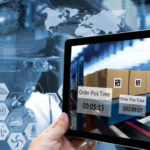SMART
FACTORY, INDUSTRY 4.0 & IOT
In the not-so-distant future, all technologies will be integrated and will cooperate to create a smarter, efficient whole; this is called the internet of things (IoT).
To the manufacturing world, that means that facilities will become smart factories. When all aspects of the plant – from shop floor to sales – are interconnected digitally, the data gained from IoT creates transparency into manufacturing operations. Management and IT departments work in harmony within blended data and production areas, transforming the manufacturing process from a complex of isolated silos into a seamless production environment.
IoT On The Floor
Three essential elements need to come together to accomplish this transition of the self-contained traditional manufacturing plant into a connected, advanced smart factory:
- Connected machines: Digital communication between sensor-equipped machines on the factory floor, purchasing departments with intelligent software, digitally run truck fleets and linked-in materials suppliers.
- Real-time and predictive analytics: Real-time data collection and automated review using powerful algorithms. Turns data into insights.
- People empowered by IT: Connected to the data and supported by automated analytics, managers and supervisors can achieve a higher level of wise decision-making.
The foundation of IoT is that smart machines capture and communicate this information instantly to connected parts of an organization. Therefore, issues are identified more quickly. Armed with this information in real-time, supervisors make better decisions to deal with issues before a problem can get out of hand. In some cases, intelligent machines can self-correct without delaying production at all. It is a decentralization of production control and depends upon massive amounts of data, well-written code, and a new culture on the factory floor. Workflows become integrated into the whole system.
How IoT Has Already Changed Everything
The smart factory of the future will involve massive technological interconnection from start (customers) to finish (shipping), blurring the boundaries of responsibility. Many firms allow customers to place and track orders electronically. Shipping trucks, under the same premise, can be queued up with minimal manual planning. Lean manufacturing techniques now involve constant communication with suppliers and transport. A world in which smart, automated manufacturing provides full visibility of all aspects of business and business insights is not difficult to envision.
New business models will emerge once the concept of location is no longer pertinent to the manufacturing process; product components can be made anywhere if all factory operations are inter-linked. The human factor may become more tied to information technology proficiency than to on-the-spot manual jobs. Decision-making informed with analysis insights may become a responsibility at all stages of production, rather than from the top-down. Manufacturers may partner more closely with suppliers, customers, transport firms, who all have access to the same real-time data on ongoing projects. Machine to machine communications may make adjustments automatically according to agreed upon protocol and KPIs.
The Internet of Things incorporates intelligent machines, big data, automation, and a scheme to use advanced analysis to identify business insights. It will transform the manufacturing process into a seamless whole incorporating everything from initial product design to product delivery.
Smart Factory, Industry 4.0 and IoT
With PlanetTogether Scheduling, you’ll create better production schedules much faster with Microsoft Dynamics AX. Plus, those schedules will take your material and capacity constraints into account, so you’ll know that commitments made will be commitments that are met.

Smart Factory APS Demo
Smart Factory, Superplant, Industry 4.0 and IoT will all demand and provide optimized efficiency from your ERP, MRP or MES system – see how.



